TV personality knives have always gotten a bad rap from the bushcraft community. Far too often companies overplay their hands and throw in marketing crap into a tool that is supposed to be practical in nature. This pessimism isn’t helped with products like the first “Survivorman” knife I reviewed, which if you remember didn’t go down so well. When I heard Helle had teamed up with Les to create his ideal bushcraft knife, the Helle Temagami, I was tentatively hopeful. Helle is an old school company from Norway and I just don’t see them throwing in some obnoxious branding or colour scheme just to sell a few more knives to fans of the show.
And I was right. This is a legit, honest-to-goodness bushcraft knife that evokes the same aesthetic lines as the Ray Mears Bushcraft Knife or the Condor equivalent. Obviously, the Temagami has a few quirks that make it very interesting (in my opinion), but the point I want to stress before we get on with the review is that this is a tool that I genuinely see Les Stroud using. The Temagami is a true Scandinavian blade, which happens to be molded to fit Les Stroud’s own biases when it comes to a cutting tool.
The Helle Temagami is the first “famous survivalist designed” product tie in that I feel really speaks to the essence of the individual. It’s common for TV personalities to license their brand, but it’s rare for me to handle these products and really feel like this is what the individual would use if cameras weren’t watching. A good example would be the Bear Grylls Parang – I personally really dig that machete, but I pretty much ignore the branding and genuinely question how much influence Bear Grylls had with that design beyond making sure people knew it had his name on it.
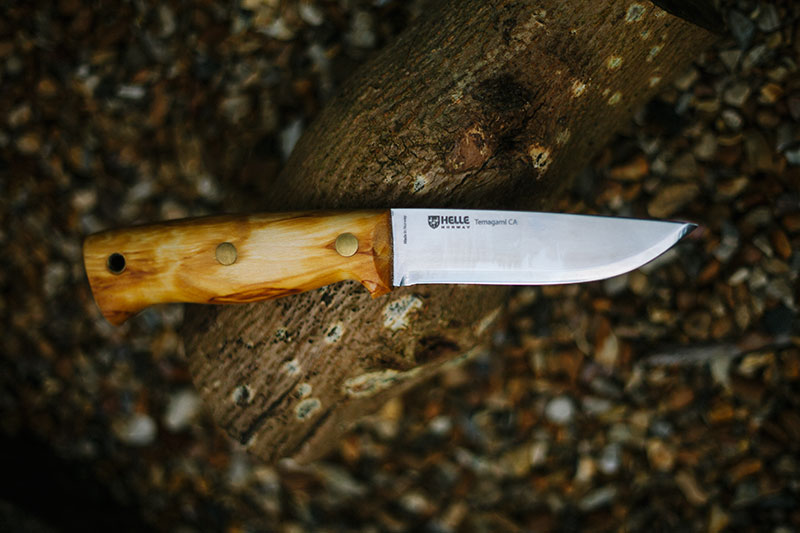 Helle Temagami Fixed Blade Survival Knife – Amazon / Blade HQ
Helle Temagami Fixed Blade Survival Knife – Amazon / Blade HQ
Visually, beyond the super clean Scandinavian line and very pretty handles, the Temagami doesn’t strike me as anything other than a well made “standard” bushcraft knife. Its design is conservative in nature and its cutting bias is heavily geared towards wood processing and comfort. Nothing about this knife screams “Hollywood marketing ploy,” and that’s a good thing. These bushcraft knives tend to all look (more or less) the same for a reason: it works, folks.
You can’t really beat a Scandi ground 4 inch blade and nicely shaped curly birch handles for general use. Too often a designer will go crazy with a specific requirement or feature and it will ruin the feel of the knife for general tasks. Every quirk this knife has is designed to complement its general purpose – not supplant it.
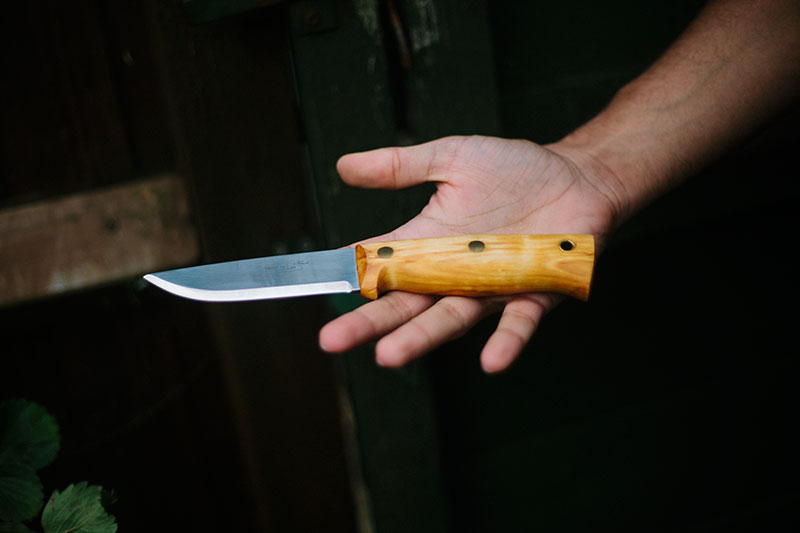
Interestingly, Helle opted to go with a 3/4 full tang (more on this further below). I personally really dig this as it makes the knife far more comfortable in cold conditions. Obviously, I speak as a former resident of the Great North, but if you look at traditional Scandinavian designs, they tend to be stick tangs. This is for a very good reason – cold steel (pun unintended) and exposed skin are two things that just don’t mix well.
The shaping of the handle is nicely neutral compared to the “skinny” hourglass options by Bark River (like the Bravo). I personally prefer this as I like bigger handles. As far as comfort goes, the Temagami is probably the most comfortable knife I have ever handled, and due to its neutral design, I imagine this would be the same for you regardless of the size of your hands.
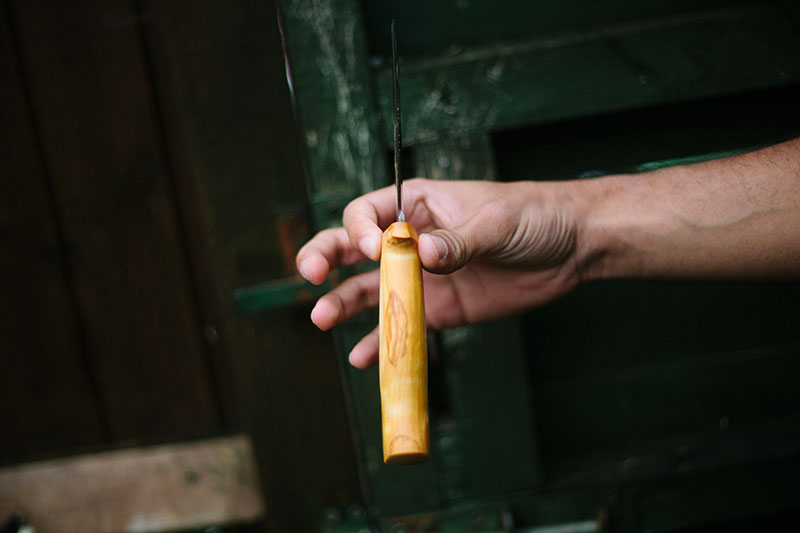
So as you can see, the tang goes all the way down. People often associate 3/4 full tangs as a cost saving measure, but it’s actually more expensive to produce than a true full tang. The tolerances have to be much tighter and you really don’t lose much steel by going this route. That said, you do shave enough weight that it is noticeable. This knife weighs in at 153 grams, which is damn impressive, and the resulting balance is perfect.
The Temagami feels almost like an extension of your arm when you are actually using it; something that the bulkier “survival/bushcraft” knives frequently fail at.
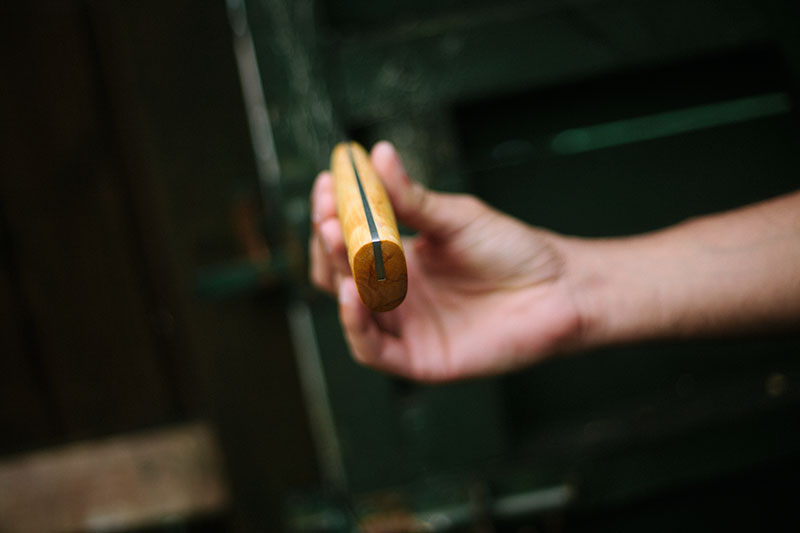
Balance is important for bushcraft because when it comes to a bushcraft knife’s tasks, they are varied. If your blade is very long and heavy, it will limit your ability to do detailed carving. If it’s too small and light with a bias towards the handle, then its ability to exert pressure with larger tasks, like cutting large branches to size, will be more work than it should be. When you have a tool that’s supposed to be your only companion in the woods, it’s a balancing act to get the right amount of blade and weight.
I think Helle/Les Stroud nailed it with this one, and the balance is comparable to the excellent Condor Bushlore, which I really love.
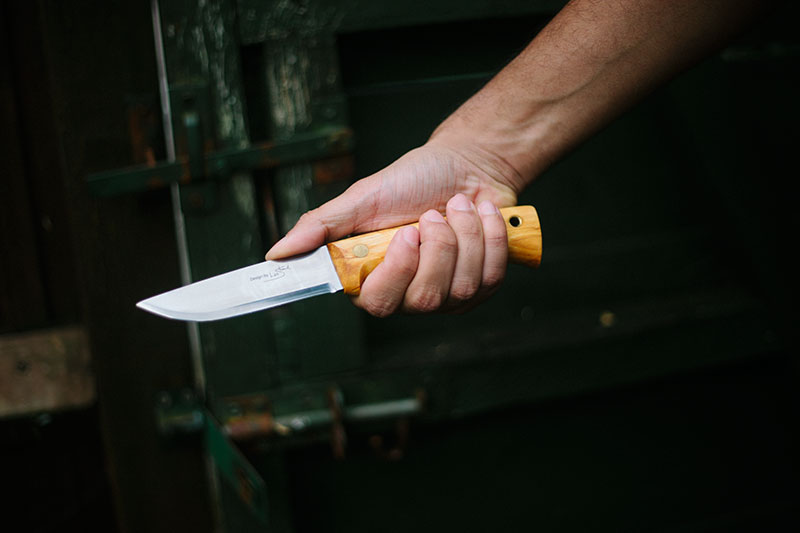
Unlike the more tactical survival knives, the Temagami has curves and shapes designed to encourage proper grips for the proper job. No obnoxious guards here. You can pinch or choke your way up with zero difficulty. Speaking of grips, no hot spots of any kind regardless of how I held the knife. I think this is a consequence of using natural materials like wood without obsessing over aggressive swoops and contours. It fills your palm in a very natural way.
In terms of in-hand retention, I don’t have an issue with that, but then again I have always been happy with the feel of the classic Moras. Maybe I am just old and stuck in my ways. In any case, bare in mind that this knife isn’t textured and offers zero jimping. Perfectly fine by me, but your mileage may vary.
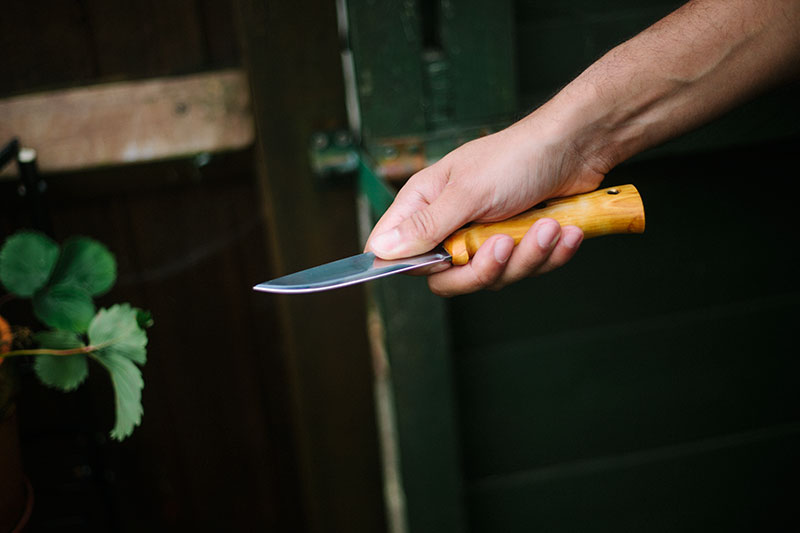
In terms of actual performance, it’s a box standard high end Scandinavian knife. 3 mm thick blade stock made of laminated stainless or carbon steel. I chose the carbon steel version denoted by a CA attached to the end of the name, but that’s a superficial bias. I like carbon steel, but frankly if you gave me the stainless version, I wouldn’t notice much difference (if any). The grind of the edge is super clean and whilst the handles do differ from one batch to the next (byproduct of the handmade element of this knife) the blade is meticulously ground and sharpened with a beautiful mirror polish.
Out of the box sharpness was above average (Spyderco levels), and the Temagami’s carving ability was what you would expect: phenomenal.
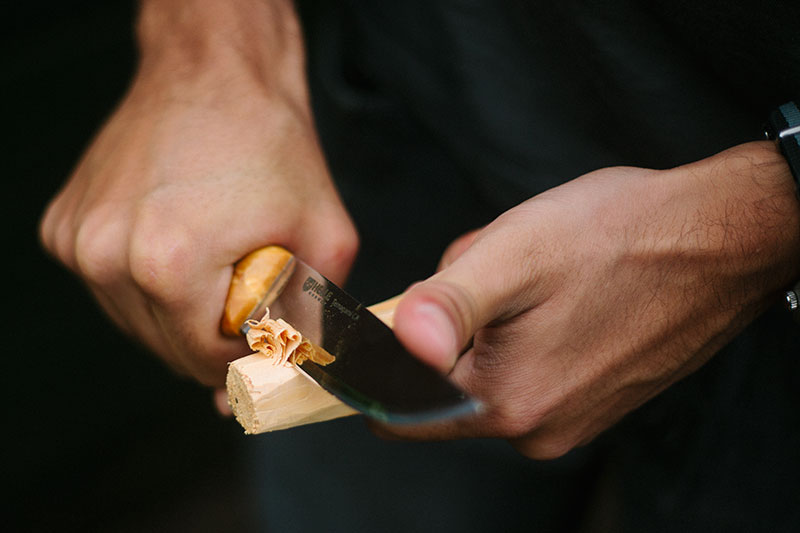
Reviewing bushcraft knives is always interesting to me because they all share such similarities, and performance on wood insofar as the cutting goes tends to be almost identical. The difference for me is the comfort whilst cutting; that is the difference between a good and a bad bushcraft knife. It’s not hard to make a good wood carver. The “recipe” is generic – 3 mm – 5 mm thick blade stock, Scandinavian ground to a zero edge, and that blade will feather sticks and carve spoons all day long.
The real issue is: how will your hands feel after a few hours of carving? That’s the real question, and as for the Helle Temagami – my hands will feel just fine, thank you very much. When it comes to cutting, I favour reversing the blade as you can see below (Ray Mears has influenced my style, as he was my first introduction to bushcraft), and this Helle was natural and comfortable regardless of how I handled the blade. It’s so nice to have a knife that is so meaty and comfortable out of the box.
The obvious comparison is the Condor Bushlore, but the reality is that the Condor is a budget product with rougher finish and boxy’ish handles. They need some work before reaching the level of comfort the Helle Temagami out-of-box provides. I don’t think I could “improve” the ergonomics of this knife, not even a little bit.
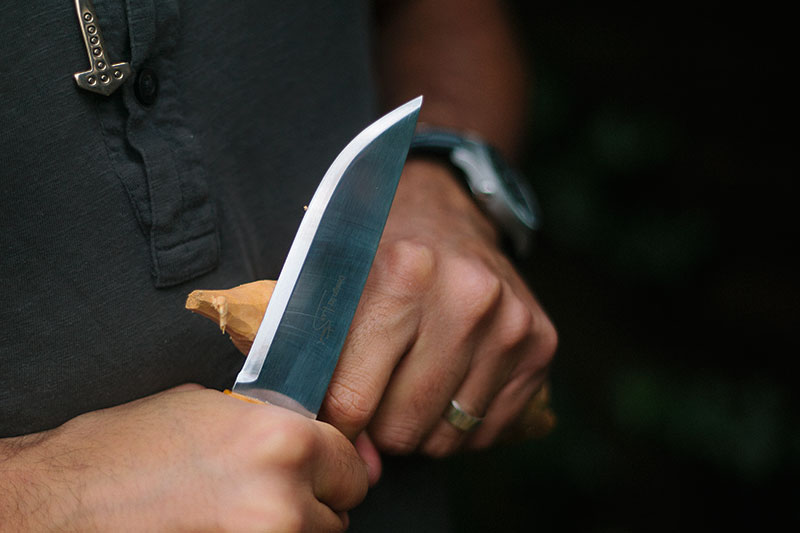
Edge retention is above average thanks to the superb steel and rockwell hardness of 58HRC’ish (this is a guess based on my impressions). I can’t comment much on the metallurgy as the advertising doesn’t mention the exact composition. I would wager that the carbon steel core is something similar to 1095 and the stainless steel cladding is equivalent to 420. In practical terms, it’s relatively stain resistant outside of the edge itself and toughness is superb due to the laminated construction.
Something to note for those who want their knives to always look pristine – the stainless steel outer layer is relatively soft and thus will 100% get scratches if you baton with it, as I did.
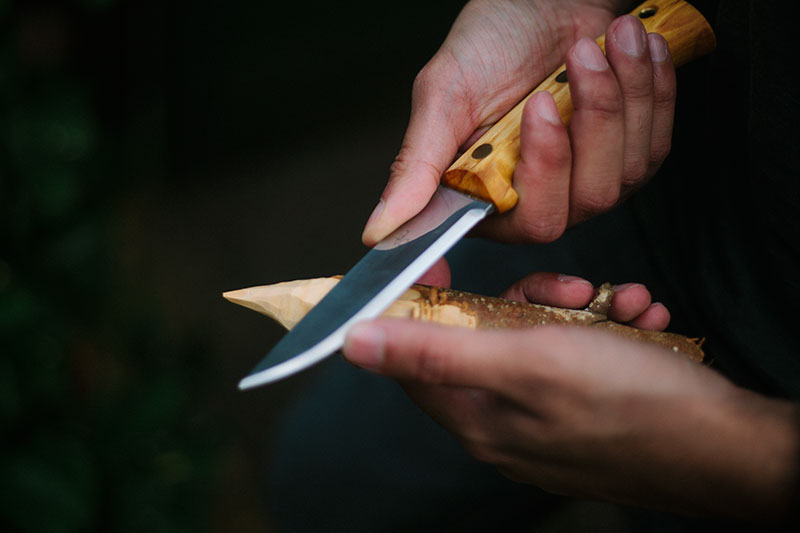
Batoning is a breeze as expected. No uncomfortable vibrations unlike my experiences with the Cold Steel Bushman. The Helle Temagami tears through wood without mercy and your only limitation will be the length of the blade. Significantly better than your average Mora and on par with my L.T. Wright Genesis.
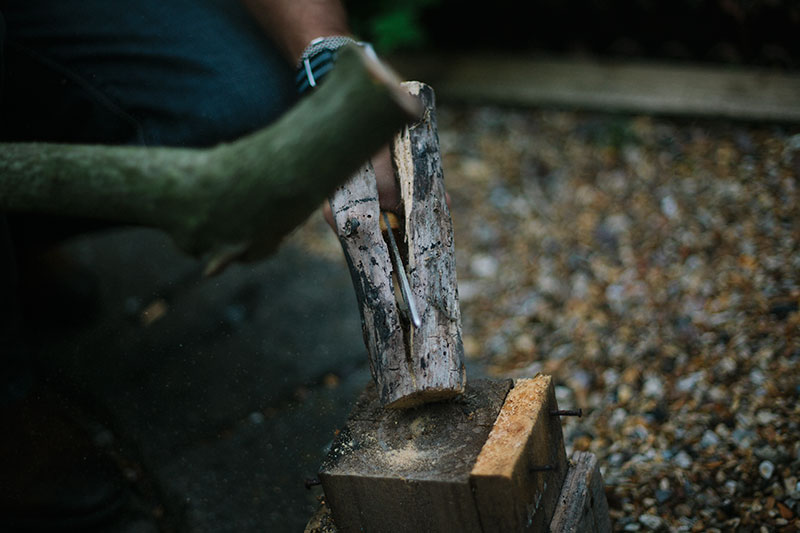
The best thing about the Helle Temagami is something I rarely see discussed. The blade likes to bite downwards as you can see below. It’s not a straight slab and the real world consequence of this design choice is that cutting and carving feels very natural with a very natural bite. This is significantly different from the bulk of bushcraft knives on the market and something that I think should be adopted as the industry norm. That slight downward slope means that despite having a straight edge, it feels almost like a recurve when you pull a branch towards you as you carve.
It’s hard to explain, but I think you get what I am saying here.
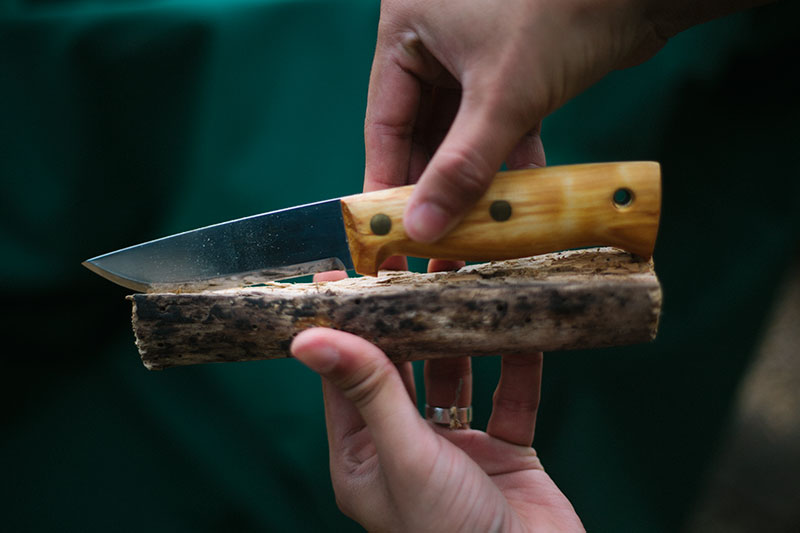
As for carrying options, it comes with a super simple leather sheath. Retention is solid, construction is solid, stitching is solid. You know what? It’s simply solid.
I would have liked a firesteel hoop, but I know the stainless steel cladding isn’t optimal for that, so I understand the oversight. I should mention that the lanyard hole is large and can handle pretty much any lanyard. I personally shan’t be using any, doesn’t feel right with a bushcraft knife, but I know some of you will appreciate that.
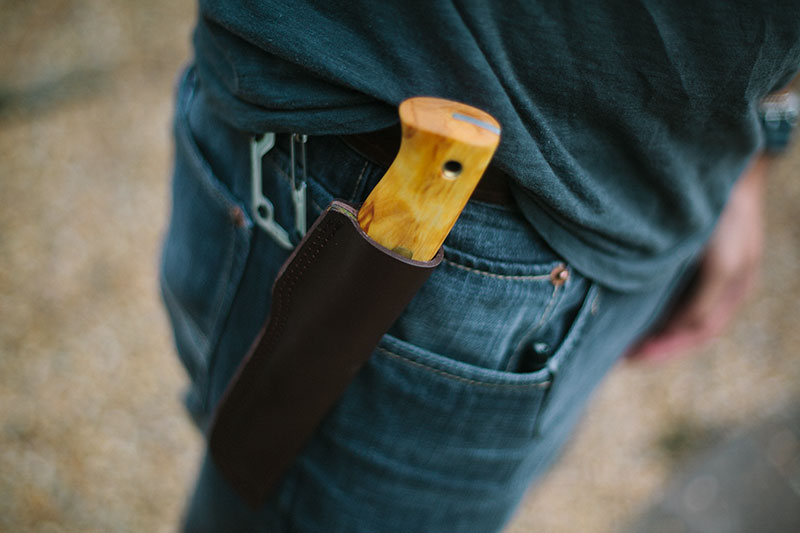
Nothing in this knife was added to push a product or to make it “unique” for the sake of marketing. This is simply a really solid bushcraft knife with some really smart quirks that happened to be influenced/designed by Les Stroud and this is something noteworthy in this day and age. So many new survival knives get released every year with new crap attached to them or “multi-feature blades” that look like garbage, but can open bottles, etc. etc.
It’s a sad state of affairs. The Helle Temagami is in one word, honest. It’s an honest knife that doesn’t try to be something it’s not, and I applaud Les & Helle for that, especially after the weirdness that was the Camillus Survivorman SK Mountain.
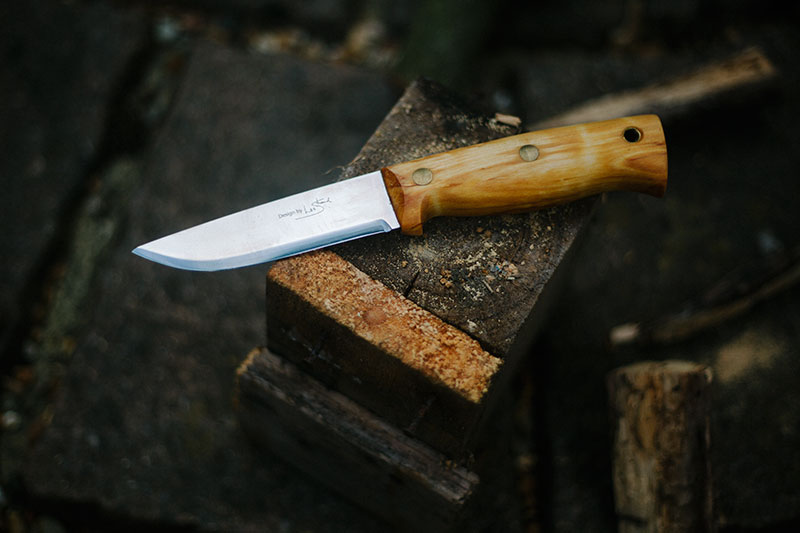
So, should you buy it? If you want a high end bushcraft knife with superb ergonomics, then I reckon it’s a solid bet.
I don’t see anyone ever handling the Helle Temagami and being unhappy. I used the terms neutral and balanced excessively during this review and honestly, that’s what it is.
I can’t comment on anything specific like the lock or unique blade shape because its simply a well balanced 4″ bushcraft knife with best-in-class ergonomics and a nice downward bite.
Make of that what you will. As for me – this is now my go-to outdoor blade.
Stainless steel may be heat-treated to great hardness, as can “carbon steel.” So one cannot acurately generalize on hardness,based solely on whether the steel is “stainless’ or not.
Greenwood is often carved.
“I can’t comment on anything specific like the lock ….” I can see why you cannot comment on the knife’s “lock” – it has none, being, as you say, a fixed-blade knife.
Love the knife. Half tang, not 3/4, so far as I see on mine on yours as pictured above, on every one pictured — half the height of the handle (slightly under half by micrometer). Seems plenty for a knife. More, say 3/4. would have made it ever more handle-heavy. Helle calls it a “semi-full tang ,’ as any tang is — another name being “partial.” Amazon, when it was selling them: “about half the width of a full tang.” “The tang is not full but fills half of the handle,” review,http://embersurvival.com/blog/helle-temagami-review-carbon-steel-version/
I refer to that style of tang as 3/4 as it reflects the inherent strength compared to tangs that go only halfway down the handle. In my view, the Temagami is as strong as any full tang- the definition is frankly quite ridiculous as the Fallkniven F1 is considered full tang and yet its not the width of the handle and depending on how pedantic one wishes to be, one could say its hefty stick tang (check out photographs of people stripping the handles)- so the discrepancy in terminology is frequently suspect and I go with my own interpretation. Check out the Ontario Raider Bowie for another example- is it a full tang? Half tang? Stick Tang? Dependending on the definition one chooses to employ, it could meet all of these.
Anywho, agreed with your assessment- definitely plenty of oomph for any job I can think of.
Hi, I hope this will explain if the “triple-laminated stainless” steel has the carbon steel core or not (it has). Quote from Helle:
http://www.helle.no/built-to-last/materials/
The steel in Helle knives is unique
The differences between a Helle knife and other knives are many. The biggest difference lies in our triple laminated stainless steel blade. The core is made of high alloy steel which gives it a lasting, razor-sharp edge. This harder layer cannot however exclude the threat of rust or breakage.
To exploit the superb qualities of the high alloy steel we added two layers of tough stainless steel(18/8) to protect the blade against breakage and corrosion, while the high carbon core still provides a superb cutting edge. This triple laminated stainless steel is unique to our knife blades.
The steel we use is more expensive than in most other knife brands, but that is all a part of Helles philosophy of never compromising on quality.
Thanks for the info EB!
Thanks for a great review. I just bought this knife. I do read many wonder what kind of steel to go for. Well i did myself but at the end i picked up the stainless one tho. I belive since this this is a laminated knife with an inner carbon edge you will be able to have the edge hardness of carbon if its sharpen right so in that case you will be able to have the best of both. But the ca verson will most likly be easyer to resharpen but will require more maintance. Im no expert but this is my thought.
Was wrong about the middle layer. They say its all stainless
Hi!
I have a Helle Temagami CA and this is not stainless steel knife!
It’s full carbon steel same as Helle Viking (I have too).
The blade darkens after contact with blood or tomato or similar aggressive liquids. This can easily be completely blacked out by means of Birchwood Casey or similar.
Although this knife rusts but it cuts better than the stainless version.
The hardness of my Temagami CA is about 60-61 HRC. It’s can scratch the glass.
I have knife with old type sheath is fully symmetrical, suitable for both the right and left sides. It’s more compact than new version and more like traditional scandi.
I haven’t noticed much difference in steel performance between the temagami and mandra (CA vs Laminated Stainless), have you tried the stainless from Helle? Very curious to know what your experience was!
Thanks for dropping by!
In my opinion Triple Laminated Stainless Steel softer then Triple Laminated Carbon Steel from Helle. CA cuts more aggressively but easily gets chipped and rusted.
I think it’s steel for an experienced user who knows exactly what tasks he needs a knife for. Stainless steel is more universal and does not require much care. This will be the best choice for most users.
I agree that carbon steel is harder than stainless in gerneral but i belive the middle layer in helle stainless knives is of carbon so that will explain why he dont feel the difference
Ups yh it says tripple stainless then i guess my comment could be deleted
Good review! The company has always made good products.
If you are a beginning knife collector, read the 1 and 2 level of critical comments on Amazon about the knife. You will then be able to skip some misconceptions of the general public:
1. “stainless steel” does not mean that you can ignore basic cleaning and maintenance. Stainless steel will rust, darn it!
2. when knives are handmade, there will always be a series of imperfections;
3. when you use a knife, you can expect to experience scratches and sometimes gouges.
4. there are good reasons why you don’t use a knife as though it were an axe and why you should not cut through green wood with any knife.
Survivalist television programs are as real as television wrestling. Why do you watch it? If you want to know about a certain knife, watch a number of youtube reviews and read the confirmed customer reviews on Amazon.
Oh man, I always feel like slamming my head against the keyboard whenever a forum posts appears along the lines of “my stainless steel knife rusted, what the hell?”.
Mate, its in the name. Stain-LESS. Not stain-Proof!
As for the confirmed customer reviews, I don’t particularly trust them- I suspect quite a few are shills/paid for and the lack of information on the reviewer in question makes me uneasy. I prefer doing a quick google search and looking for reviews with original photographs (too many spam sites with stock photos) to get a general idea of how it will handle.
The interesting thing for me, is that personal biases matter so much and as you get more into this hobby you discriminate against certain quirks that other people love. An example being the ergonomics on the Spyderco Pingo (check out the review if you want)- I absolutely hate it but some people love it. It just goes to show that different strokes for different people is an apt saying.
Please elaborate – Why should I never cut green wood with any knife?! I usually cut green wood, I’m a bodger. Seasoned wood is hard work! I’ve never heard this before and cannot think why it could be a bad idea. Thanks.